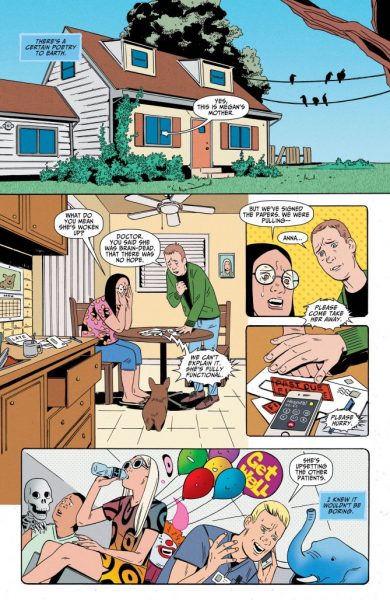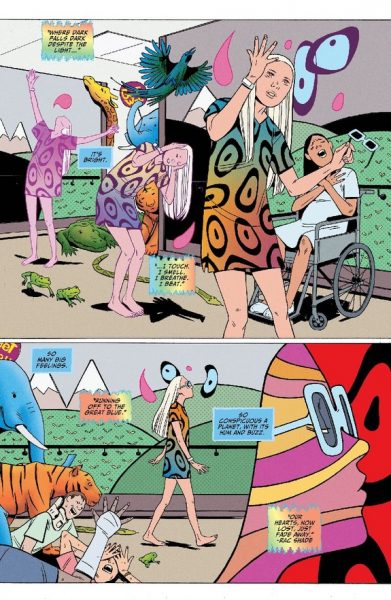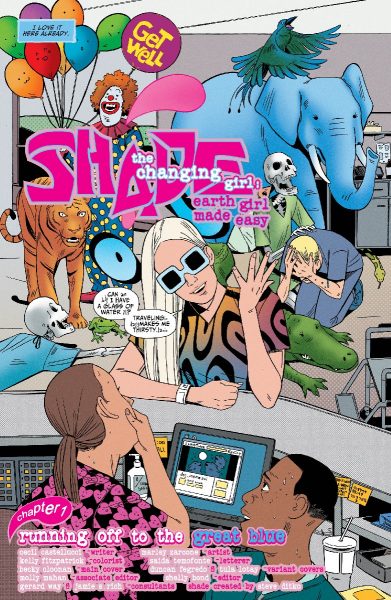Shade, the Changing Girl #1 Review (SPOILERS)
"You Crazy Diamond"
Recently, I took a look at the possibility that
Young Animal, a new imprint of DC Comics run by comic book writer and musician Gerard Way, could become a sort of new Vertigo Comics. Way’s
Doom Patrol #1 arrived and was interesting and out there. However, the other title that I was very intrigued by was
Shade, the Changing Girl. In fact,
Shade, the Changing Girl #1 proves to be a refreshingly original and exciting comic. It does feel in some ways like the old Vertigo stuff, especially the titles that were only loosely tied into the regular DCU like
The Sandman and
Saga of the Swamp Thing. Yet
Shade, the Changing Girl #1 really is very different from those books and works well as its own thing.
 Shade, the Changing Girl
Shade, the Changing Girl #1 begins with teenager Megan Boyer waking from a coma (caused by an accident) from which no one expected her to emerge. However, we know from the start that it’s not really Megan. Something else is in place of her mind. It turns out to be Loma, a bird-like creature from Meta, a planet from another dimension. Loma dons a coat of Rac Shade, which transports her to Megan’s body. The first twist of this story is that Megan was a horrible person prior to her accident. So her parents are relieved but also confused by her change from a mean girl into a philosophical one. Her social circle has more reservations about Megan's return. The bigger story twist is that it turns out they played a large part in her “accidental” near drowning.
Whereas Way’s first issue of
Doom Patrol was compelling if a bit impenetrable,
Shade, the Changing Girl #1 is straight forward by comparison. It’s not necessarily an easy issue to read by "Big-Two" standards. There are some definite weird parts. However, the issue is not even close to the type of obtuse, experimental comics occurring in the indie world. If a reader pays attention,
Shade, the Changing Girl makes sense. There is enough strangeness, though, for this to feel unique and fresh. Still, it’s not weirdness for weirdness’ sake. There is method to the small bits of madness.
 Shade, the Changing Girl
Shade, the Changing Girl #1 is a nice example, too, of a writer-artist team working well together. Writer Cecil Castellucci tells a pretty complex story within the one issue, efficiently setting up the characters and the central situation. She also injects a lyrical quality to the narration. These passages injects a dreamy element to
Shade, the Changing Girl #1 while still being tied to the actual story. Castellucci’s work is subtly strong, but artist Marley Zarcone is the star here. Along with colorist Kelly Fitzpatrick, Zarcone creates a dazzling series of pages. Her figures at times look like grotesques out of Charles Burns’ work. Other times, they are gorgeous, trippy pop art. Fitzpatrick’s kaleidoscopic colors also add a great deal to the themes and look of the issue.
Shade, the Changing Girl #1 feels something like a Vertigo title, and is also a descendant from an actual Vertigo Comic. The series is a spin-off of
Shade, the Changing Man, a book from writer Peter Milligan and artist Chris Bachalo. It was one of the first Vertigo titles. That series was based on a character created by comic legend Steve Ditko in 1977. The central character of these stories was Rac Shade from the planet Meta. Rac is mentioned in passing in
Shade, the Changing Girl #1. It’s the sort of reference that doesn’t take a reader out of the story, though you are aware that it’s something important.

Young Animal’s central conceit seems to be moving forward while looking back – specifically at the old, weird corners of the DC Universe (the ones Grant Morrison has always liked). Their efforts seem to be succeeding, at least so far. In
Shade, the Changing Girl #1, there is great deal of originality and energy. Castellucci and Zarcone manage the tricky task of telling a relatable story that is also very inventive. There are many new series that start slowly and gradually get a little better with each issue. This is not one of them.
Shade, the Changing Girl #1 comes out full force with an impressive first issue. Hopefully, Castellucci and Zarcone can sustain the relatable parts of the Earth story while exploring the unusual elements of Shade and Meta.
Pros
- The art from Zarcone and colors from Fitzpatrick are superb
- Castellucci sets up characters, setting and the main premise well
- The feel of this comic is pretty unique
Cons
- Not a comic for readers who like punch 'em ups
 Shade, the Changing Girl #1 begins with teenager Megan Boyer waking from a coma (caused by an accident) from which no one expected her to emerge. However, we know from the start that it’s not really Megan. Something else is in place of her mind. It turns out to be Loma, a bird-like creature from Meta, a planet from another dimension. Loma dons a coat of Rac Shade, which transports her to Megan’s body. The first twist of this story is that Megan was a horrible person prior to her accident. So her parents are relieved but also confused by her change from a mean girl into a philosophical one. Her social circle has more reservations about Megan's return. The bigger story twist is that it turns out they played a large part in her “accidental” near drowning.
Whereas Way’s first issue of Doom Patrol was compelling if a bit impenetrable, Shade, the Changing Girl #1 is straight forward by comparison. It’s not necessarily an easy issue to read by "Big-Two" standards. There are some definite weird parts. However, the issue is not even close to the type of obtuse, experimental comics occurring in the indie world. If a reader pays attention, Shade, the Changing Girl makes sense. There is enough strangeness, though, for this to feel unique and fresh. Still, it’s not weirdness for weirdness’ sake. There is method to the small bits of madness.
Shade, the Changing Girl #1 begins with teenager Megan Boyer waking from a coma (caused by an accident) from which no one expected her to emerge. However, we know from the start that it’s not really Megan. Something else is in place of her mind. It turns out to be Loma, a bird-like creature from Meta, a planet from another dimension. Loma dons a coat of Rac Shade, which transports her to Megan’s body. The first twist of this story is that Megan was a horrible person prior to her accident. So her parents are relieved but also confused by her change from a mean girl into a philosophical one. Her social circle has more reservations about Megan's return. The bigger story twist is that it turns out they played a large part in her “accidental” near drowning.
Whereas Way’s first issue of Doom Patrol was compelling if a bit impenetrable, Shade, the Changing Girl #1 is straight forward by comparison. It’s not necessarily an easy issue to read by "Big-Two" standards. There are some definite weird parts. However, the issue is not even close to the type of obtuse, experimental comics occurring in the indie world. If a reader pays attention, Shade, the Changing Girl makes sense. There is enough strangeness, though, for this to feel unique and fresh. Still, it’s not weirdness for weirdness’ sake. There is method to the small bits of madness.
 Shade, the Changing Girl #1 is a nice example, too, of a writer-artist team working well together. Writer Cecil Castellucci tells a pretty complex story within the one issue, efficiently setting up the characters and the central situation. She also injects a lyrical quality to the narration. These passages injects a dreamy element to Shade, the Changing Girl #1 while still being tied to the actual story. Castellucci’s work is subtly strong, but artist Marley Zarcone is the star here. Along with colorist Kelly Fitzpatrick, Zarcone creates a dazzling series of pages. Her figures at times look like grotesques out of Charles Burns’ work. Other times, they are gorgeous, trippy pop art. Fitzpatrick’s kaleidoscopic colors also add a great deal to the themes and look of the issue.
Shade, the Changing Girl #1 feels something like a Vertigo title, and is also a descendant from an actual Vertigo Comic. The series is a spin-off of Shade, the Changing Man, a book from writer Peter Milligan and artist Chris Bachalo. It was one of the first Vertigo titles. That series was based on a character created by comic legend Steve Ditko in 1977. The central character of these stories was Rac Shade from the planet Meta. Rac is mentioned in passing in Shade, the Changing Girl #1. It’s the sort of reference that doesn’t take a reader out of the story, though you are aware that it’s something important.
Shade, the Changing Girl #1 is a nice example, too, of a writer-artist team working well together. Writer Cecil Castellucci tells a pretty complex story within the one issue, efficiently setting up the characters and the central situation. She also injects a lyrical quality to the narration. These passages injects a dreamy element to Shade, the Changing Girl #1 while still being tied to the actual story. Castellucci’s work is subtly strong, but artist Marley Zarcone is the star here. Along with colorist Kelly Fitzpatrick, Zarcone creates a dazzling series of pages. Her figures at times look like grotesques out of Charles Burns’ work. Other times, they are gorgeous, trippy pop art. Fitzpatrick’s kaleidoscopic colors also add a great deal to the themes and look of the issue.
Shade, the Changing Girl #1 feels something like a Vertigo title, and is also a descendant from an actual Vertigo Comic. The series is a spin-off of Shade, the Changing Man, a book from writer Peter Milligan and artist Chris Bachalo. It was one of the first Vertigo titles. That series was based on a character created by comic legend Steve Ditko in 1977. The central character of these stories was Rac Shade from the planet Meta. Rac is mentioned in passing in Shade, the Changing Girl #1. It’s the sort of reference that doesn’t take a reader out of the story, though you are aware that it’s something important.
 Young Animal’s central conceit seems to be moving forward while looking back – specifically at the old, weird corners of the DC Universe (the ones Grant Morrison has always liked). Their efforts seem to be succeeding, at least so far. In Shade, the Changing Girl #1, there is great deal of originality and energy. Castellucci and Zarcone manage the tricky task of telling a relatable story that is also very inventive. There are many new series that start slowly and gradually get a little better with each issue. This is not one of them. Shade, the Changing Girl #1 comes out full force with an impressive first issue. Hopefully, Castellucci and Zarcone can sustain the relatable parts of the Earth story while exploring the unusual elements of Shade and Meta.
Young Animal’s central conceit seems to be moving forward while looking back – specifically at the old, weird corners of the DC Universe (the ones Grant Morrison has always liked). Their efforts seem to be succeeding, at least so far. In Shade, the Changing Girl #1, there is great deal of originality and energy. Castellucci and Zarcone manage the tricky task of telling a relatable story that is also very inventive. There are many new series that start slowly and gradually get a little better with each issue. This is not one of them. Shade, the Changing Girl #1 comes out full force with an impressive first issue. Hopefully, Castellucci and Zarcone can sustain the relatable parts of the Earth story while exploring the unusual elements of Shade and Meta.